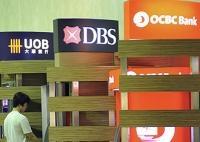
Which local bank is most exposed to rapidly rising interest rates?
Its net profit might jump by as much as 17%.
Banks are a big beneficiary of rising interest rates, especially following the Monetary Authority of Singapore’s (MAS) surprise decision last week to allow the SGD to appreciate less by reducing the slope of its policy band.
Analysts concur that among Singapore’s three biggest banks, DBS stands to benefit most as rates climb steadily upward. DBS is backed by its strong deposit franchise, which allows it to keep its funding cost low in a rising rate environment.
“One of the by-products of this exchange rate policy is the increase in interest rates. The SWAP rate is 0.8% today versus last year’s average of 0.29%. The 3-month inter-bank rate is 0.65% vs. 0.42% in 2014. This benefits the Singapore banks, in particular DBS, because its assets get repriced faster and in a bigger magnitude than liabilities. Approximately 40% of DBS’s S$ loans are pegged to the SWAP rate, 40% to the interbank and the remaining are fixed rates,” Nomura analyst Jaj Singh wrote in a report.
BNP Paribas analyst Frank Yuen added that DBS’ strong position is further boosted because it has the shortest bond durations, which will allow its net interest margins (NIM) to expand faster than those of its peers.
He wrote that in the last rate hike cycle in 2003 to 2006, DBS was the first bank to react when interest rate started to move.
“We believe this was because DBS had a more liquid balance sheet than its peers with assets such as interbank debt repricing faster. In contrast, OCBC’s and UOB’s NIM expansion lagged DBS’s with NIMs only expanding when the 1M Sibor started to fall in 2007. Both banks attributed the NIM expansion to falling funding costs, in their management discussions. This showed, in the last episode, that OCBC and UOB did not benefit at first when rates started to move which may be due to their lower CASA balances than DBS (with funding costs more sensitivity to rate hikes) and lower levels of excess liquidity,” he noted.
Yuen estimates that the banks’ NIMs might expand by 16-24bp and net profit by 11-17% per 100bp parallel shift in the Sibor.
























 Advertise
Advertise






